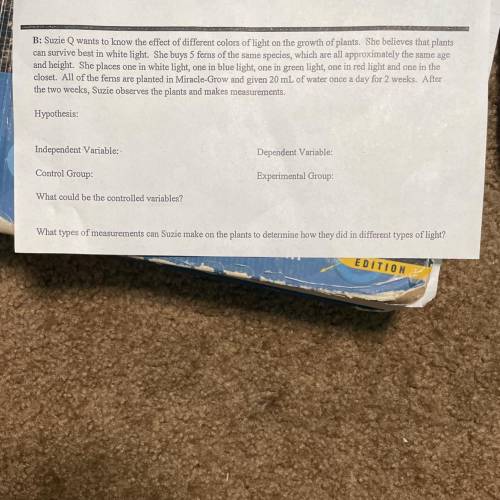
B: Suzie Q wants to know the effect of different colors of light on the growth of plants. She believes that plants
can survive best in white light. She buys 5 ferns of the same species, which are all approximately the same age
and height. She places one in white light, one in blue light, one in green light, one in red light and one in the
closet. All of the ferns are planted in Miracle-Grow and given 20 mL of water once a day for 2 weeks. After
the two weeks, Suzie observes the plants and makes measurements.
Hypothesis:
Independent Variable:
Dependent Variable:
Control Group:
Experimental Group:
L
What could be the controlled variables?
What types of measurements can Suzie make on the plants to determine how they did in different types of light?


Answers: 2
Another question on Biology

Biology, 22.06.2019 01:00
Nucleic acid certain protein cell membranes certain carbohydrates
Answers: 1

Biology, 22.06.2019 04:00
Will mark brainliest i only need the ! 1.use ten beads and a centromere of one color to construct the long chromosome. use ten beads and a centromere of a second color to construct the second chromosome in the long pair. make a drawing of the chromosomes in the space below. 2. for the second pair of chromosomes, use only five beads. 3. now model the replication of the chromosomes. make a drawing of your model in the space below. part b: meiosis i during meiosis i, the cell divides into two diploid daughter cells. 4. pair up the chromosomes to form tetrads. use the longer tetrad to model crossing-over. make a drawing of the tetrads in the space below. 5. line up the tetrads across the center of your “cell.” then model what happens to the chromosomes during anaphase i. 6. divide the cell into two daughter cells. use the space below to make a drawing of the result. part c: meiosis ii during meiosis ii, the daughter cells divide again. 7. line up the chromosomes at the center of the first cell, one above the other. separate the chromatids in each chromosome and move them to opposite sides of the cell. 8. repeat step 7 for the second cell. 9. divide each cell into two daughter cells. use the space below to make a drawing of the four haploid cells
Answers: 1

Biology, 22.06.2019 04:00
Number and variety of living organisms includes genetic, species, and ecological types
Answers: 3

Biology, 22.06.2019 07:00
What was the purpose of mendel's experiments with dihybrid crosses? a. to determine if dna was a transforming factor b. to determine if traits could be recessive c. to determine if traits affected each other d. to determine if traits had more than one allele
Answers: 3
You know the right answer?
B: Suzie Q wants to know the effect of different colors of light on the growth of plants. She believ...
Questions

Mathematics, 21.08.2019 09:30

Social Studies, 21.08.2019 09:30

Mathematics, 21.08.2019 09:30

Physics, 21.08.2019 09:30


History, 21.08.2019 09:30



Mathematics, 21.08.2019 09:30

Health, 21.08.2019 09:30




Mathematics, 21.08.2019 09:30

Mathematics, 21.08.2019 09:30

Mathematics, 21.08.2019 09:30


History, 21.08.2019 09:30

Business, 21.08.2019 09:30



